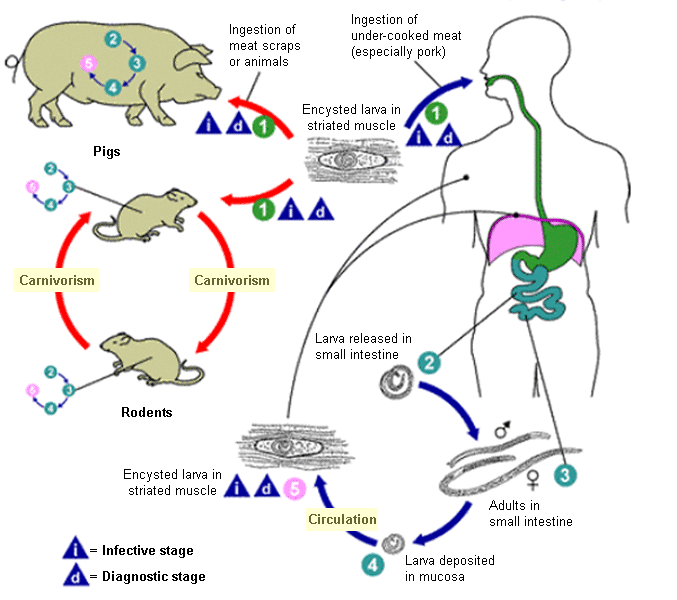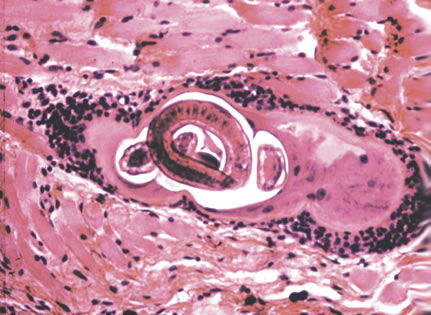Aetiology
Trichinella (phylum: Nematode, class: Adenophorea, family: Trichinellidae) is a roundworm parasite that, although capable of infecting a wide variety of mammals, birds, and reptiles, causes disease only in humans.[22] Humans acquire the parasite accidentally through ingestion of raw or improperly cooked pork, horse, or other domestic animal meat and from wild game. Transmission of trichinellosis to humans has been reported mainly in association with mammal meat consumption; however, occasionally the disease has been acquired by ingestion of reptile meat, including turtles and lizards.[23] Heating meat to an internal temperature of 63°C (144°F) inactivates the larvae. There is no risk of human-to-human transmission.
The parasite exists in two life cycles: domestic and sylvatic.
Domestic cycle
Exists in areas where traditional pig-rearing practices are used, such as eastern Europe, South America, and Asia.[24] The prevalence of the domestic cycle, which perpetuates in pigs through the consumption of rodents, tail biting, or ingestion of poorly cooked kitchen waste or carcasses, may have been fuelled by political and financial difficulties that favour the proliferation of small, unregulated farms, and by the collapse of government veterinary services in developing countries.[3]
As the domestic cycle does not occur in industrial pig farms, it has not been reported in the US, Canada, or western Europe.
Sylvatic cycle
The sylvatic cycle may affect mammals, birds, and reptiles, and is perpetuated by scavenging or cannibalistic animal habits. Despite the wide range of reservoirs of the sylvatic cycle, selected animals, including bears, cougars, walrus, and, in particular, swine (wild pigs, wild boars, bush pigs, and warthogs), represent a higher risk to humans, as they are commonly hunted and consumed.[25]
Pathophysiology
Following the ingestion of infected meat (i.e., muscle) by humans or animals, pepsin and hydrochloric acid in the stomach cause the release of first-stage larvae that invade the columnar epithelium of the small intestine. In humans, this invasion may be completely asymptomatic or be associated with mild diarrhoea and nausea. After moulting four times, larvae become adults and mate. The female worms produce newborn larvae, thus completing the enteric or gastrointestinal phase of the parasite life cycle.[26]
In the systemic (parenteral) phase, the newborn larvae pass into the lymphatic circulation and eventually into the blood circulatory system, reaching skeletal muscles and other highly oxygenated tissues such as the myocardium and brain. The classic clinical manifestations of trichinellosis (myalgia, facial oedema, fever, and eosinophilia) occur during this phase.
All larvae are hosted in a nurse cell but, depending on the species, they may become encysted within a collagen capsule or remain free in the muscle. Although both encapsulated and non-encapsulated organisms can remain viable for years, encapsulated larvae survive substantially longer and remain infective even within putrefied muscle tissue.[27]
Pigs and rodents are the most important agents in maintaining the cycle of infection.[28][Figure caption and citation for the preceding image starts]: Life cycle of Trichinella speciesFrom: Laboratory Identification of Parasites of Public Health Concern, Centers for Disease Control and Prevention (CDC); used with permission [Citation ends]. [Figure caption and citation for the preceding image starts]: Larva of Trichinella spiralis in a muscle nurse cellFrom: Summary of Basic Science and Clinical Information section of The Trichinella Page (http://www.trichinella.org); used with permission from Dr Dickson Despommier [Citation ends].
[Figure caption and citation for the preceding image starts]: Larva of Trichinella spiralis in a muscle nurse cellFrom: Summary of Basic Science and Clinical Information section of The Trichinella Page (http://www.trichinella.org); used with permission from Dr Dickson Despommier [Citation ends].
Classification
Taxonomic classification[1][2]
Formerly, only one species (Trichinella spiralis) of the genus Trichinella was recognised, but multiple species have been added based on variation of several genetic loci. Currently, 12 taxa (including species and genotypes yet to be defined) are recognised and sub-classified according to the presence or absence of an intramuscular collagen capsule.
Encapsulated species
Trichinella britovi: affects sylvatic mammals in temperate areas of Africa, Asia, and Europe
Trichinella murrelli: affects sylvatic carnivores in Canada and the US
Trichinella nativa: affects sylvatic carnivores in Arctic areas
Trichinella nelsoni: affects sylvatic carnivores in eastern and southern Africa
Trichinella spiralis: affects domestic and sylvatic mammals worldwide
Trichinella genotype T6: affects sylvatic carnivores in Canada and the US
Trichinella genotype T8*: affects sylvatic carnivores in southern Africa
Trichinella genotype T9*: affects sylvatic carnivores in Japan
Trichinella genotype T12*: affects cougars in Argentina.
* Transmission has not been documented in humans.
Non-encapsulated species
Trichinella papuae: affects wild pigs and crocodiles in Thailand and Papua New Guinea
Trichinella pseudospiralis: affects sylvatic animals worldwide
Trichinella zimbabwensis*: affects crocodiles and lizards in Africa.
* Transmission has not been documented in humans.
Cycle classification[3]
Trichinella occurs in different life cycles depending on the type of animal it parasitises.
Sylvatic cycle: affects wildlife
Domestic cycle: affects domestic animals, particularly swine
Synanthropic cycle: affects animals that serve as a link between the sylvatic and the domestic cycles (i.e., rats, foxes, mustelids, cats, and dogs).
Use of this content is subject to our disclaimer